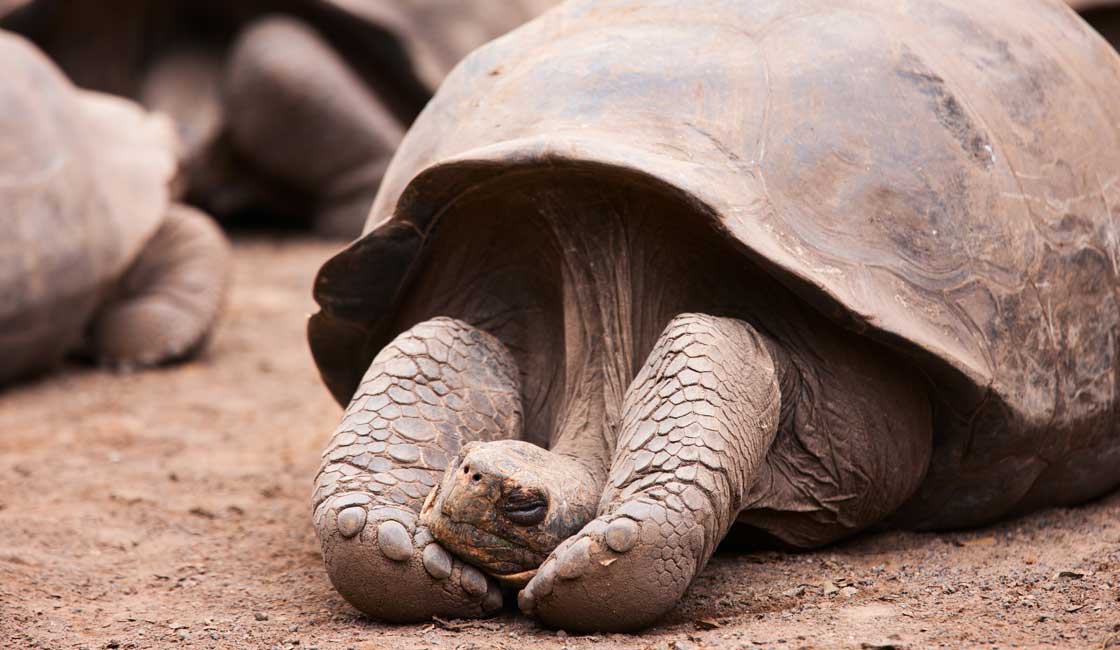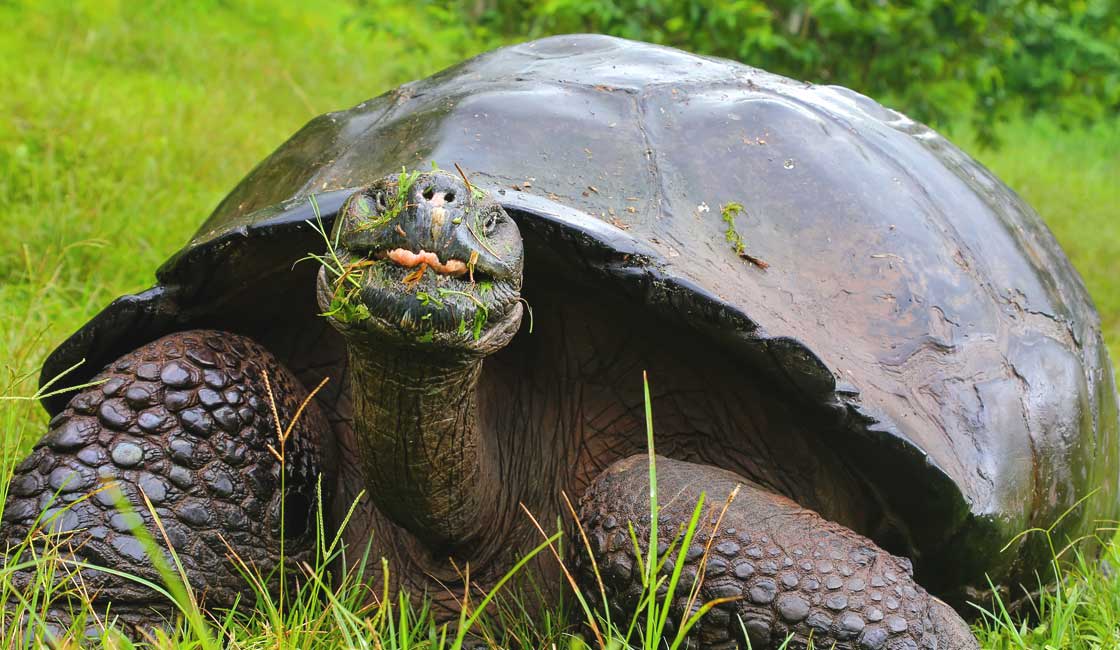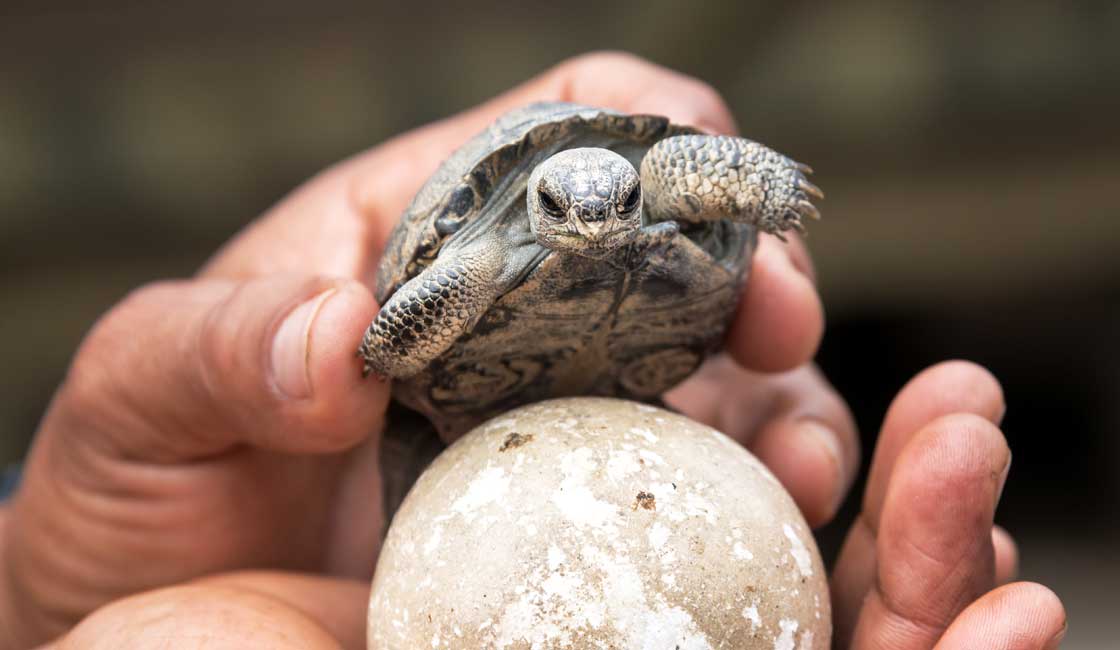
Giant tortoises are synonymous with the Galapagos, being top of the “must-see” list of many visitors. In fact, the islands were named after the tortoises by the Spanish sailors who first discovered the archipelago in 1535 (the Spanish word for tortoise being galapago). These impressive creatures are virtually unique to the Galapagos and have become a flagship species for conservation efforts throughout the islands. Read on to learn some fascinating facts about this most iconic of Galapagos species.

A Walk
Galapagos tortoises have a large bony shell of a dull brown, light green or grey color. The plates of the shell are fused with the internal skeleton, providing the tortoise with a rigid protective structure. The shell is also comprised of honeycomb structures containing small air chambers that help the tortoise bear its weight more easily. Tortoises have large, stumpy limbs covered in hard scales which they can withdraw into their shell for protection against hot temperatures or when they feel threatened.
The most striking feature of the giant tortoise is of course its huge size. Galapagos tortoises are the world’s largest tortoises, averaging around 4 feet in length and weighing around 472 pounds. However, they can exceed 5 feet and reach up to 550 pounds. The original ancestors of the tortoises were probably of normal size and it was likely their gradual evolution on the islands that gave rise to this gigantism. This may be due to their relative lack of natural predators, meaning they had less need to hide from threats or compete with other animals over resources. It is also likely that a larger size was selected for overtime as this enables the tortoise to store more water and fat reserves and so endure long ocean crossings or survive in drought-prone climates.
Another characteristic feature of Galapagos tortoises is their longevity. The average lifespan in the wild is over 100 years, whilst in captivity, they are known to live even longer than this, with the oldest tortoise on record being 170 years old. This makes them the longest living of all vertebrate species. It has even been speculated that among the tortoises living in the Galapagos today, there may still exist a small handful that were alive at the time of Darwin’s nineteenth-century visit.

16 Hours A Day
Giant tortoises are thought to have once thrived across most continents but are now confined to just the Galapagos islands, along with one other remote archipelago – the Aldabra Atoll, located some 700 km east of Tanzania in the middle of the Indian Ocean. All the species of giant tortoises found in the Galapagos are native to the islands, but all evolved from a common ancestor which journeyed from the mainland (floating on ocean currents or riding on vegetation rafts) to arrive at the islands around 2 to 3 million years ago. This seems like an incredible journey, especially for such a heavy and cumbersome animal, but giant tortoises can in fact float quite easily in salt water.
Today, there are around 15,000 giant tortoises inhabiting the islands, with a few different sub-species scattered around several of the islands. Darwin encountered the tortoises on his famous 1835 Beagle voyage, and the observations he made – particularly in terms of the differences in the shape of the shells – helped contribute to the development of his theory of evolution. The giant tortoises colonized the easterly islands first, starting with Española and San Cristobal and then gradually dispersed across the others, eventually establishing 15 distinct populations across 10 of the islands. The tortoise populations evolved separately on their isolated islands, giving rise to the differences we see today, as well as providing evidence for environmental adaptation and natural selection.
There are two main types of Galapagos tortoises, each one demonstrating adaptations to the specific environmental conditions of their particular island. The first type has dome-shaped shells and are the larger of the two with less flexible necks. They inhabit the larger islands with humid highlands and plentiful ground foliage, such as Santa Cruz. The second type has saddle-shaped shells, are smaller and characterized by their longer necks. They are found on smaller islands with dry lowlands, such as Española and Pinzón, where food is more limited. These differences are thought to be the result of a feeding adaptation. The saddle-backs evolved in drier areas where they needed to stretch their heads upwards to reach vegetation that grows higher off the ground, such as vines, leaves, cactus pads and fruits. Meanwhile, the domed tortoises are simply able to graze on the grass beneath them, hence the shorter neck and more restrictive shell.

Being Adorable While Grazing
Galapagos tortoises lead a rather sedate lifestyle, sleeping up to 16 hours a day and spending the rest of the day foraging and basking in the sun. Being cold-blooded they need to absorb sufficient heat from the sun to provide them with enough energy. They also travel around, moving from resting to grazing areas, whilst some populations migrate from drier areas to the highlands with changing seasons, though all this is done at a rather leisurely pace of 0.3 km/h!
Tortoises are herbivores and consume a mix of grasses, leaves, nettles, berries (including some which are poisonous to humans) and other fruits, with their preferred food being cactus. In dry environments, they acquire most of their moisture from the dew and sap in the vegetation they consume. Amazingly, Galapagos tortoises can survive for up to a year without food and water. This is because of their very slow metabolism and the unique way in which they store large quantities of fat which can subsequently be broken down into the water in their bodies.
Researchers have also observed an interesting relationship between tortoises and Galapagos finches, which is a classic example of mutualism. Finches are known to perch on the shells of giant tortoises and forage around their skin in search of tasty ticks as part of their diet. The finches are even seen “dancing” in front of the tortoises to indicate they are ready to hop aboard, whilst the tortoise itself will then proceed to rise up on its legs and stretch out its neck so the bird can more easily spot and feed on any ticks. However, some Galapagos tortoises appear to be a bit sly about this. They rise above the ground, inviting a finch to pick off ticks, but then if the bird happens to venture beneath the tortoise, the reptile will suddenly drop flat to the ground and then proceed to eat the squashed bird! Scientists believe this may be an unusual feeding strategy some tortoises use to gain extra protein.

Baby Tortoise
At the time of Darwin’s visit, the Galapagos were home to some 250,000 giant tortoises. However, over the centuries, they’ve unfortunately been subject to significant exploitation, leading to the extinction of several sub-types, whilst all remaining ones are listed as either endangered or vulnerable. Galapagos tortoises were popular among sailors as a source of fresh meat during long ocean voyages, as well as being hunted for their oil. Habitat clearance and the introduction of invasive species by human visitors, particularly goats, rats and pigs, has also had a negative impact on the tortoise population. Hundreds of thousands of tortoises have been lost as a result.
Today, 12 of the 15 original tortoise populations remain and conservation efforts to encourage captive breeding are in full force. Sadly, in 2012, a fourth subspecies found on Pinta Island lost its last member – the famed Lonesome George – after failed attempts to encourage the tortoise to mate. However, there is some good news. In 2021 the Chelonoidis phantasticus species – considered extinct for more than 100 years – was found to still be in existence after Yale University compared the DNA of a tortoise found on Fernandina Island with a 1906 specimen.
Would you like to see a Galapagos Tortoise in the wild? Contact us today and inquire about booking a Galapagos tour.
While Rainforest Cruises aim to provide accurate and up-to-date information, we make no representations as to the accuracy or completeness of any information herein or found by following any link on this site. Rainforest Cruises cannot and will not accept responsibility for any omissions or inaccuracies, or for any consequences arising therefrom, including any losses, injuries, or damages resulting from the display or use of this information.




